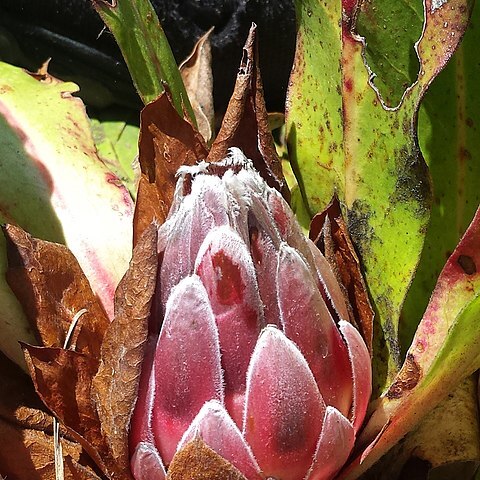A low, compact, rounded shrublet, 200-700 mm in height, forming dense tufted clumps up to 1 m in diam., with a single main stem to 40 mm in diam. and a much ramified highly contracted, tightly interlocking branch system. Stems puberulous initially, becoming glabrous, covered with persistent leaf bases. Leaves clustered around stem apices; narrowly oblanceolate to very broadly oblanceolate or very broadly obovate, 150-300 mm long, 20-95 mm wide, usually tapering and becoming winged in petiolar region, midrib very prominent; apices sharply acute to mucronate, only occasionally obtuse; densely puberulous to shaggy-velutinous initially, soon glabrous and subscabrous, though margins often remaining thickly fimbriate. Inflorescences obconic to ovoid, 45-60 mm in diam., overtopped by foliage leaves but surrounded and basally clasped by several pale brown, papyraceous, thin-textured, ovate-acute, often cymbiform leaves, 20-75 mm long, 15-30 mm wide. Involucral receptacle broadly conic, 15-20 mm in diam., 5-10 mm high. Involucral bracts 4-5 seriate, outer series ovate to ovate-oblong, obtuse, 10-20 mm long, 10 mm wide, sparsely sericeous tending to glabrescent proximally; inner series narrowly oblong to linear-spathulate, 30-35 mm long, 3-8 mm wide, sericeous, apices rounded, sericeously bearded, white or tawny. Perianth 40-45 mm long, straight; tube 8-10 mm long, quadrangular, glabrous; claws tomentose to very densely tomentose, indumentum white or tawny; limbs straight, linear-acuminate, shortly awned, 15 mm long, awns very densely lanate with a crisped indumentum, white proximally, tawny distally. Anthers 4, sessile. Style 40-45 mm long, straight, terete, occasionally very sparsely pilose proximally. Pollen presenter linear-filiform, scarcely differentiated from style, 6 mm long. Ovary narrowly obconic 2 mm long covered with 15 mm long, straight, dark brown trichomes. Hypogynous scales 1.5 mm long, oval. Flowering time differs slightly according to locality and microclimate. The Spinnekopsneskloof populations commence flowering in July, continuing until September, while in the Hottentots Holland mountains and on Olifantsberg, flowering begins in September, continuing until early November.
More
Compact, rounded shrublet to 70 cm, with tangled branches. Leaves ovate to oblanceolate, glabrescent, margins often silky. Flower heads obconic, nested among brown papery leaves, 45-60 mm diam., involucral bracts pink, silky, margins white to tawny and bearded, style 40-45 mm long.


